Accounting Policies, Change in Accounting Estimates and Errors
VerifiedAdded on 2021/06/14
|8
|1570
|22
AI Summary
Contribute Materials
Your contribution can guide someone’s learning journey. Share your
documents today.
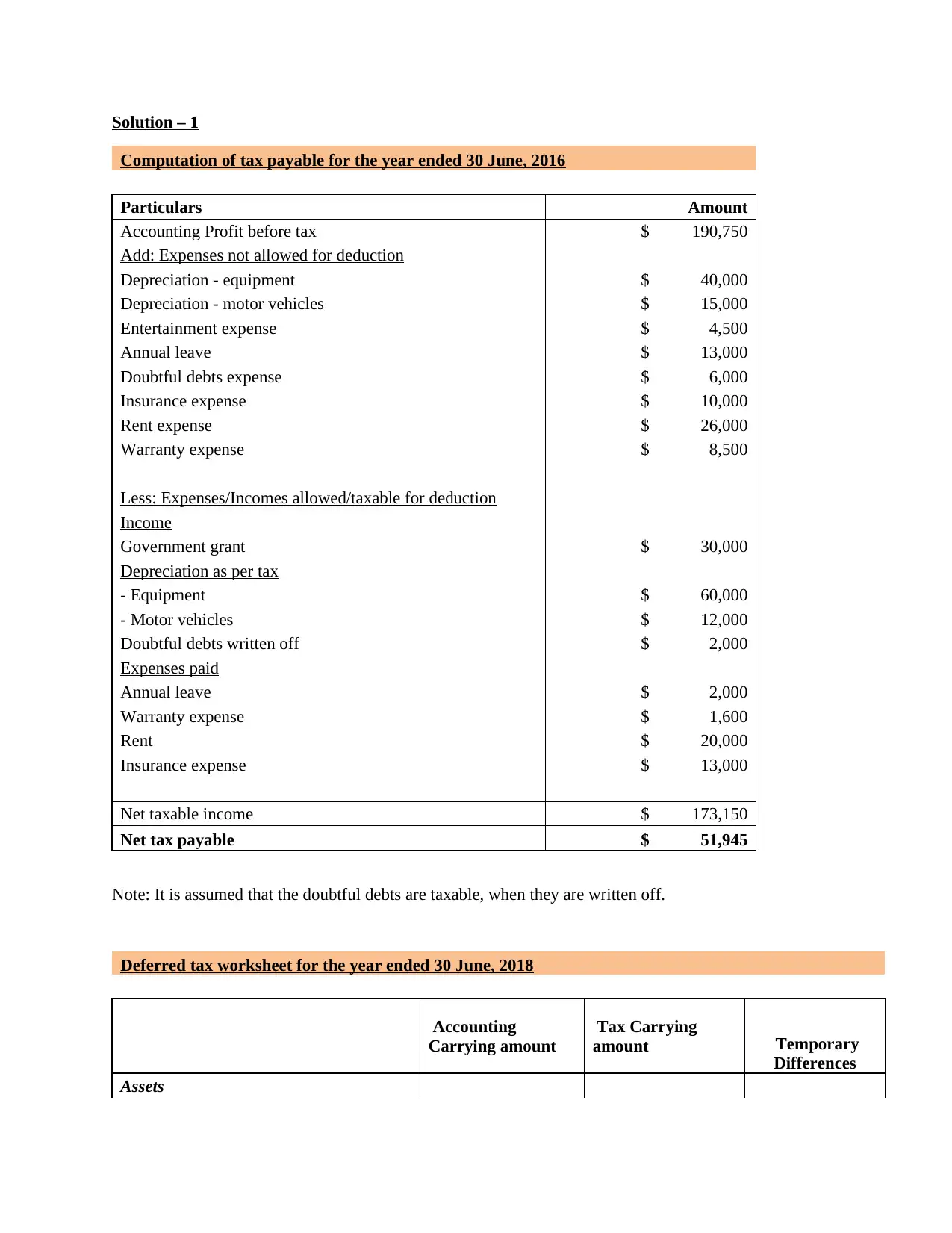
Solution – 1
Computation of tax payable for the year ended 30 June, 2016
Particulars Amount
Accounting Profit before tax $ 190,750
Add: Expenses not allowed for deduction
Depreciation - equipment $ 40,000
Depreciation - motor vehicles $ 15,000
Entertainment expense $ 4,500
Annual leave $ 13,000
Doubtful debts expense $ 6,000
Insurance expense $ 10,000
Rent expense $ 26,000
Warranty expense $ 8,500
Less: Expenses/Incomes allowed/taxable for deduction
Income
Government grant $ 30,000
Depreciation as per tax
- Equipment $ 60,000
- Motor vehicles $ 12,000
Doubtful debts written off $ 2,000
Expenses paid
Annual leave $ 2,000
Warranty expense $ 1,600
Rent $ 20,000
Insurance expense $ 13,000
Net taxable income $ 173,150
Net tax payable $ 51,945
Note: It is assumed that the doubtful debts are taxable, when they are written off.
Deferred tax worksheet for the year ended 30 June, 2018
Accounting
Carrying amount
Tax Carrying
amount Temporary
Differences
Assets
Computation of tax payable for the year ended 30 June, 2016
Particulars Amount
Accounting Profit before tax $ 190,750
Add: Expenses not allowed for deduction
Depreciation - equipment $ 40,000
Depreciation - motor vehicles $ 15,000
Entertainment expense $ 4,500
Annual leave $ 13,000
Doubtful debts expense $ 6,000
Insurance expense $ 10,000
Rent expense $ 26,000
Warranty expense $ 8,500
Less: Expenses/Incomes allowed/taxable for deduction
Income
Government grant $ 30,000
Depreciation as per tax
- Equipment $ 60,000
- Motor vehicles $ 12,000
Doubtful debts written off $ 2,000
Expenses paid
Annual leave $ 2,000
Warranty expense $ 1,600
Rent $ 20,000
Insurance expense $ 13,000
Net taxable income $ 173,150
Net tax payable $ 51,945
Note: It is assumed that the doubtful debts are taxable, when they are written off.
Deferred tax worksheet for the year ended 30 June, 2018
Accounting
Carrying amount
Tax Carrying
amount Temporary
Differences
Assets
Secure Best Marks with AI Grader
Need help grading? Try our AI Grader for instant feedback on your assignments.
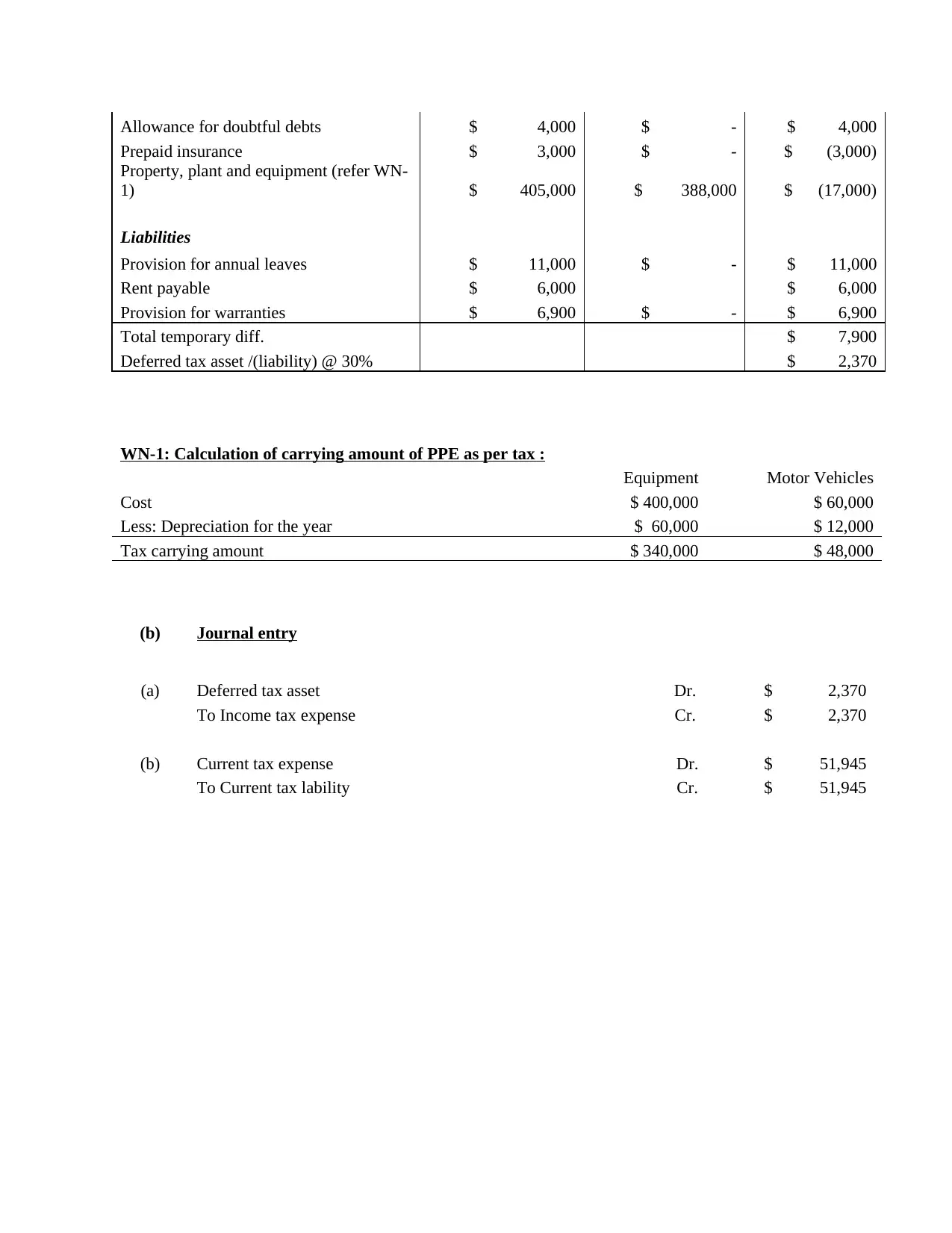
Allowance for doubtful debts $ 4,000 $ - $ 4,000
Prepaid insurance $ 3,000 $ - $ (3,000)
Property, plant and equipment (refer WN-
1) $ 405,000 $ 388,000 $ (17,000)
Liabilities
Provision for annual leaves $ 11,000 $ - $ 11,000
Rent payable $ 6,000 $ 6,000
Provision for warranties $ 6,900 $ - $ 6,900
Total temporary diff. $ 7,900
Deferred tax asset /(liability) @ 30% $ 2,370
WN-1: Calculation of carrying amount of PPE as per tax :
Equipment Motor Vehicles
Cost $ 400,000 $ 60,000
Less: Depreciation for the year $ 60,000 $ 12,000
Tax carrying amount $ 340,000 $ 48,000
(b) Journal entry
(a) Deferred tax asset Dr. $ 2,370
To Income tax expense Cr. $ 2,370
(b) Current tax expense Dr. $ 51,945
To Current tax lability Cr. $ 51,945
Prepaid insurance $ 3,000 $ - $ (3,000)
Property, plant and equipment (refer WN-
1) $ 405,000 $ 388,000 $ (17,000)
Liabilities
Provision for annual leaves $ 11,000 $ - $ 11,000
Rent payable $ 6,000 $ 6,000
Provision for warranties $ 6,900 $ - $ 6,900
Total temporary diff. $ 7,900
Deferred tax asset /(liability) @ 30% $ 2,370
WN-1: Calculation of carrying amount of PPE as per tax :
Equipment Motor Vehicles
Cost $ 400,000 $ 60,000
Less: Depreciation for the year $ 60,000 $ 12,000
Tax carrying amount $ 340,000 $ 48,000
(b) Journal entry
(a) Deferred tax asset Dr. $ 2,370
To Income tax expense Cr. $ 2,370
(b) Current tax expense Dr. $ 51,945
To Current tax lability Cr. $ 51,945
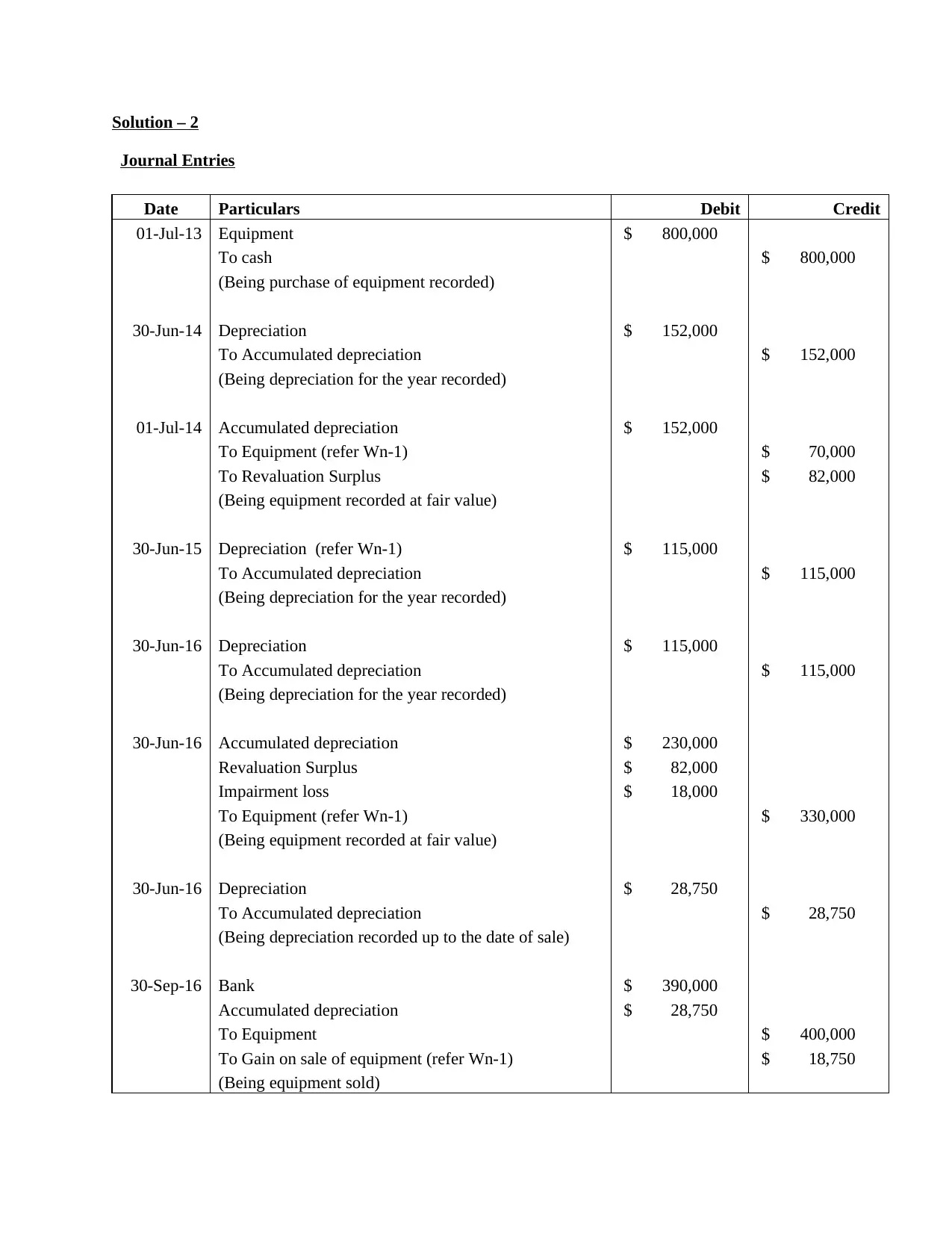
Solution – 2
Journal Entries
Date Particulars Debit Credit
01-Jul-13 Equipment $ 800,000
To cash $ 800,000
(Being purchase of equipment recorded)
30-Jun-14 Depreciation $ 152,000
To Accumulated depreciation $ 152,000
(Being depreciation for the year recorded)
01-Jul-14 Accumulated depreciation $ 152,000
To Equipment (refer Wn-1) $ 70,000
To Revaluation Surplus $ 82,000
(Being equipment recorded at fair value)
30-Jun-15 Depreciation (refer Wn-1) $ 115,000
To Accumulated depreciation $ 115,000
(Being depreciation for the year recorded)
30-Jun-16 Depreciation $ 115,000
To Accumulated depreciation $ 115,000
(Being depreciation for the year recorded)
30-Jun-16 Accumulated depreciation $ 230,000
Revaluation Surplus $ 82,000
Impairment loss $ 18,000
To Equipment (refer Wn-1) $ 330,000
(Being equipment recorded at fair value)
30-Jun-16 Depreciation $ 28,750
To Accumulated depreciation $ 28,750
(Being depreciation recorded up to the date of sale)
30-Sep-16 Bank $ 390,000
Accumulated depreciation $ 28,750
To Equipment $ 400,000
To Gain on sale of equipment (refer Wn-1) $ 18,750
(Being equipment sold)
Journal Entries
Date Particulars Debit Credit
01-Jul-13 Equipment $ 800,000
To cash $ 800,000
(Being purchase of equipment recorded)
30-Jun-14 Depreciation $ 152,000
To Accumulated depreciation $ 152,000
(Being depreciation for the year recorded)
01-Jul-14 Accumulated depreciation $ 152,000
To Equipment (refer Wn-1) $ 70,000
To Revaluation Surplus $ 82,000
(Being equipment recorded at fair value)
30-Jun-15 Depreciation (refer Wn-1) $ 115,000
To Accumulated depreciation $ 115,000
(Being depreciation for the year recorded)
30-Jun-16 Depreciation $ 115,000
To Accumulated depreciation $ 115,000
(Being depreciation for the year recorded)
30-Jun-16 Accumulated depreciation $ 230,000
Revaluation Surplus $ 82,000
Impairment loss $ 18,000
To Equipment (refer Wn-1) $ 330,000
(Being equipment recorded at fair value)
30-Jun-16 Depreciation $ 28,750
To Accumulated depreciation $ 28,750
(Being depreciation recorded up to the date of sale)
30-Sep-16 Bank $ 390,000
Accumulated depreciation $ 28,750
To Equipment $ 400,000
To Gain on sale of equipment (refer Wn-1) $ 18,750
(Being equipment sold)
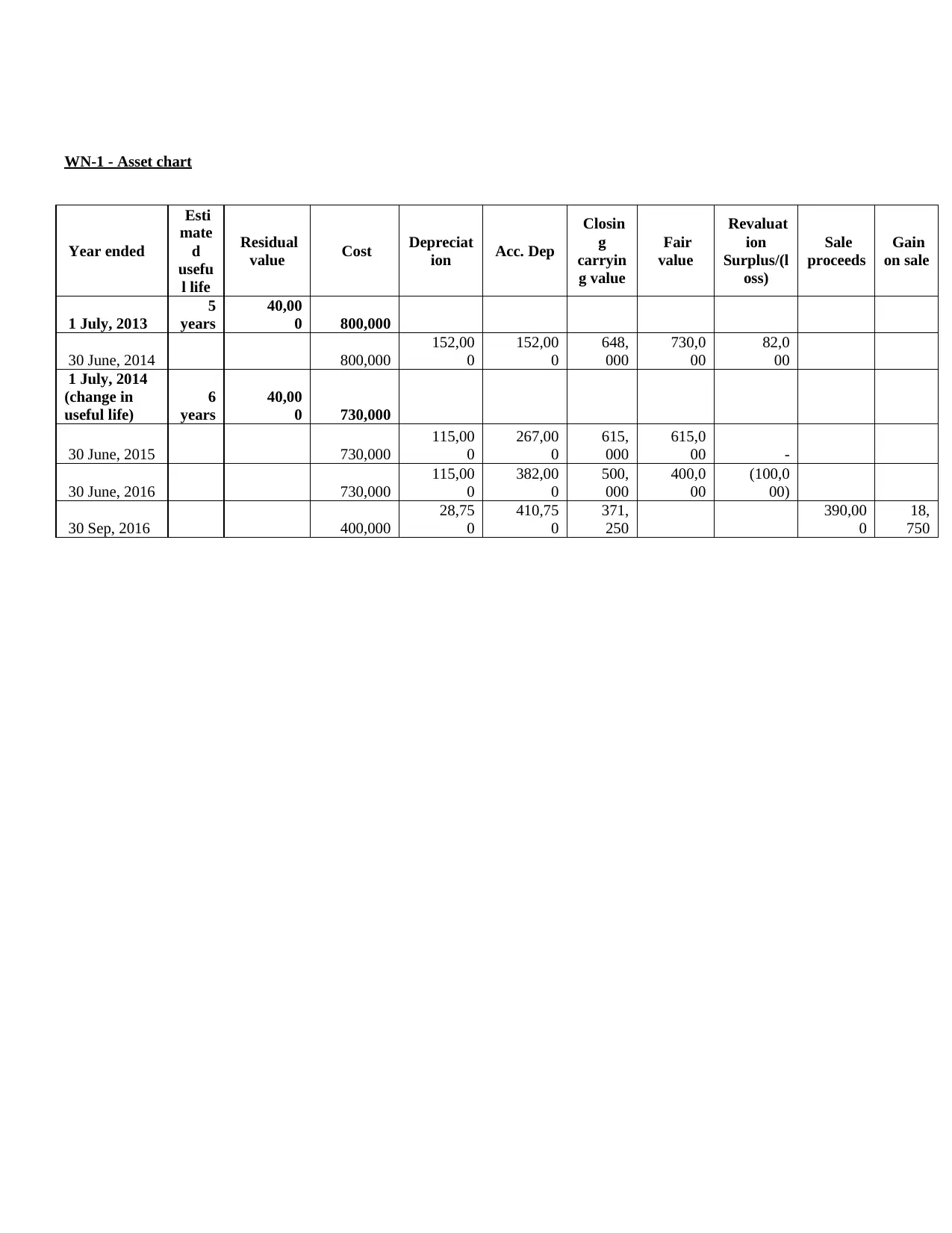
WN-1 - Asset chart
Year ended
Esti
mate
d
usefu
l life
Residual
value Cost Depreciat
ion Acc. Dep
Closin
g
carryin
g value
Fair
value
Revaluat
ion
Surplus/(l
oss)
Sale
proceeds
Gain
on sale
1 July, 2013
5
years
40,00
0 800,000
30 June, 2014 800,000
152,00
0
152,00
0
648,
000
730,0
00
82,0
00
1 July, 2014
(change in
useful life)
6
years
40,00
0 730,000
30 June, 2015 730,000
115,00
0
267,00
0
615,
000
615,0
00 -
30 June, 2016 730,000
115,00
0
382,00
0
500,
000
400,0
00
(100,0
00)
30 Sep, 2016 400,000
28,75
0
410,75
0
371,
250
390,00
0
18,
750
Year ended
Esti
mate
d
usefu
l life
Residual
value Cost Depreciat
ion Acc. Dep
Closin
g
carryin
g value
Fair
value
Revaluat
ion
Surplus/(l
oss)
Sale
proceeds
Gain
on sale
1 July, 2013
5
years
40,00
0 800,000
30 June, 2014 800,000
152,00
0
152,00
0
648,
000
730,0
00
82,0
00
1 July, 2014
(change in
useful life)
6
years
40,00
0 730,000
30 June, 2015 730,000
115,00
0
267,00
0
615,
000
615,0
00 -
30 June, 2016 730,000
115,00
0
382,00
0
500,
000
400,0
00
(100,0
00)
30 Sep, 2016 400,000
28,75
0
410,75
0
371,
250
390,00
0
18,
750
Secure Best Marks with AI Grader
Need help grading? Try our AI Grader for instant feedback on your assignments.
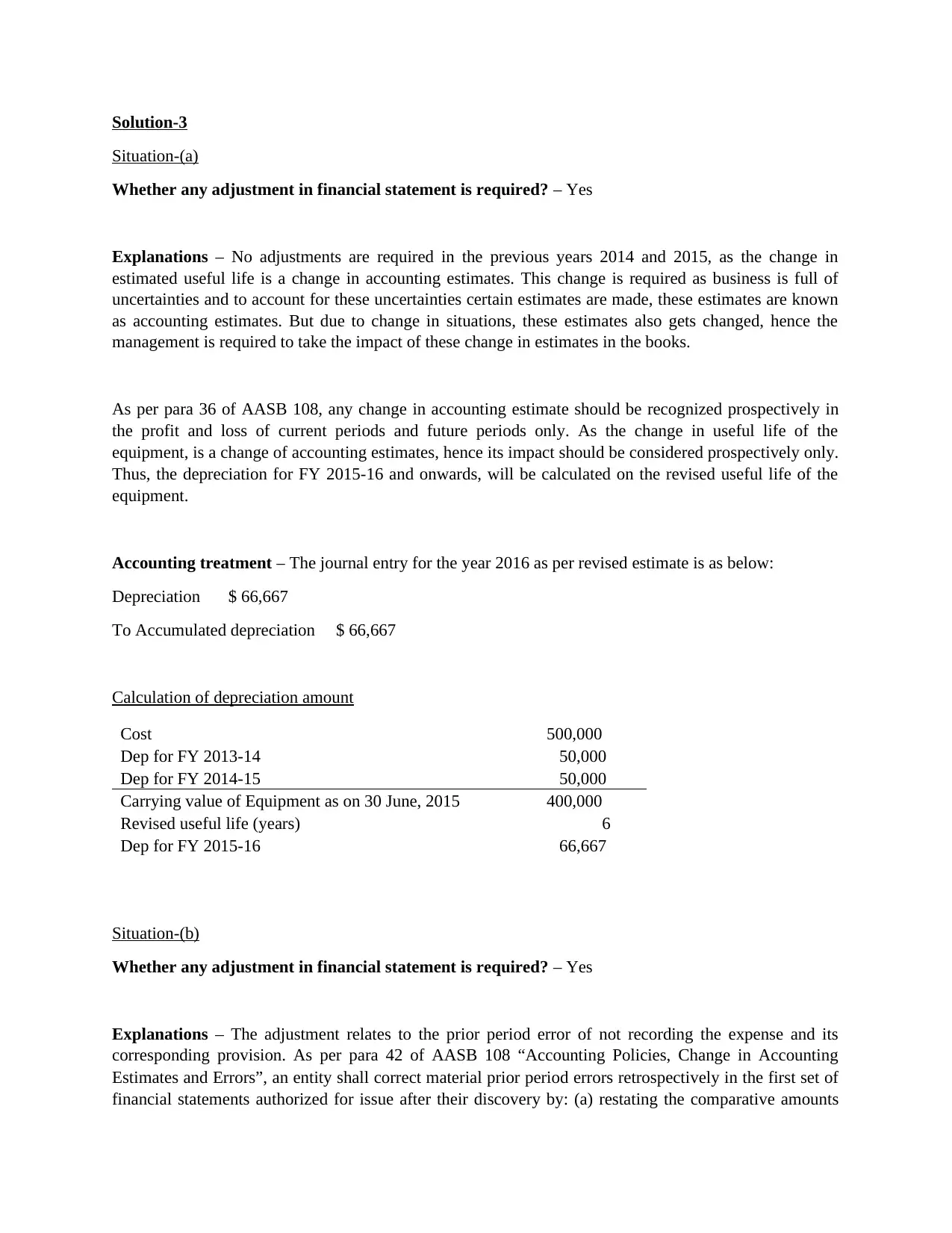
Solution-3
Situation-(a)
Whether any adjustment in financial statement is required? – Yes
Explanations – No adjustments are required in the previous years 2014 and 2015, as the change in
estimated useful life is a change in accounting estimates. This change is required as business is full of
uncertainties and to account for these uncertainties certain estimates are made, these estimates are known
as accounting estimates. But due to change in situations, these estimates also gets changed, hence the
management is required to take the impact of these change in estimates in the books.
As per para 36 of AASB 108, any change in accounting estimate should be recognized prospectively in
the profit and loss of current periods and future periods only. As the change in useful life of the
equipment, is a change of accounting estimates, hence its impact should be considered prospectively only.
Thus, the depreciation for FY 2015-16 and onwards, will be calculated on the revised useful life of the
equipment.
Accounting treatment – The journal entry for the year 2016 as per revised estimate is as below:
Depreciation $ 66,667
To Accumulated depreciation $ 66,667
Calculation of depreciation amount
Cost 500,000
Dep for FY 2013-14 50,000
Dep for FY 2014-15 50,000
Carrying value of Equipment as on 30 June, 2015 400,000
Revised useful life (years) 6
Dep for FY 2015-16 66,667
Situation-(b)
Whether any adjustment in financial statement is required? – Yes
Explanations – The adjustment relates to the prior period error of not recording the expense and its
corresponding provision. As per para 42 of AASB 108 “Accounting Policies, Change in Accounting
Estimates and Errors”, an entity shall correct material prior period errors retrospectively in the first set of
financial statements authorized for issue after their discovery by: (a) restating the comparative amounts
Situation-(a)
Whether any adjustment in financial statement is required? – Yes
Explanations – No adjustments are required in the previous years 2014 and 2015, as the change in
estimated useful life is a change in accounting estimates. This change is required as business is full of
uncertainties and to account for these uncertainties certain estimates are made, these estimates are known
as accounting estimates. But due to change in situations, these estimates also gets changed, hence the
management is required to take the impact of these change in estimates in the books.
As per para 36 of AASB 108, any change in accounting estimate should be recognized prospectively in
the profit and loss of current periods and future periods only. As the change in useful life of the
equipment, is a change of accounting estimates, hence its impact should be considered prospectively only.
Thus, the depreciation for FY 2015-16 and onwards, will be calculated on the revised useful life of the
equipment.
Accounting treatment – The journal entry for the year 2016 as per revised estimate is as below:
Depreciation $ 66,667
To Accumulated depreciation $ 66,667
Calculation of depreciation amount
Cost 500,000
Dep for FY 2013-14 50,000
Dep for FY 2014-15 50,000
Carrying value of Equipment as on 30 June, 2015 400,000
Revised useful life (years) 6
Dep for FY 2015-16 66,667
Situation-(b)
Whether any adjustment in financial statement is required? – Yes
Explanations – The adjustment relates to the prior period error of not recording the expense and its
corresponding provision. As per para 42 of AASB 108 “Accounting Policies, Change in Accounting
Estimates and Errors”, an entity shall correct material prior period errors retrospectively in the first set of
financial statements authorized for issue after their discovery by: (a) restating the comparative amounts
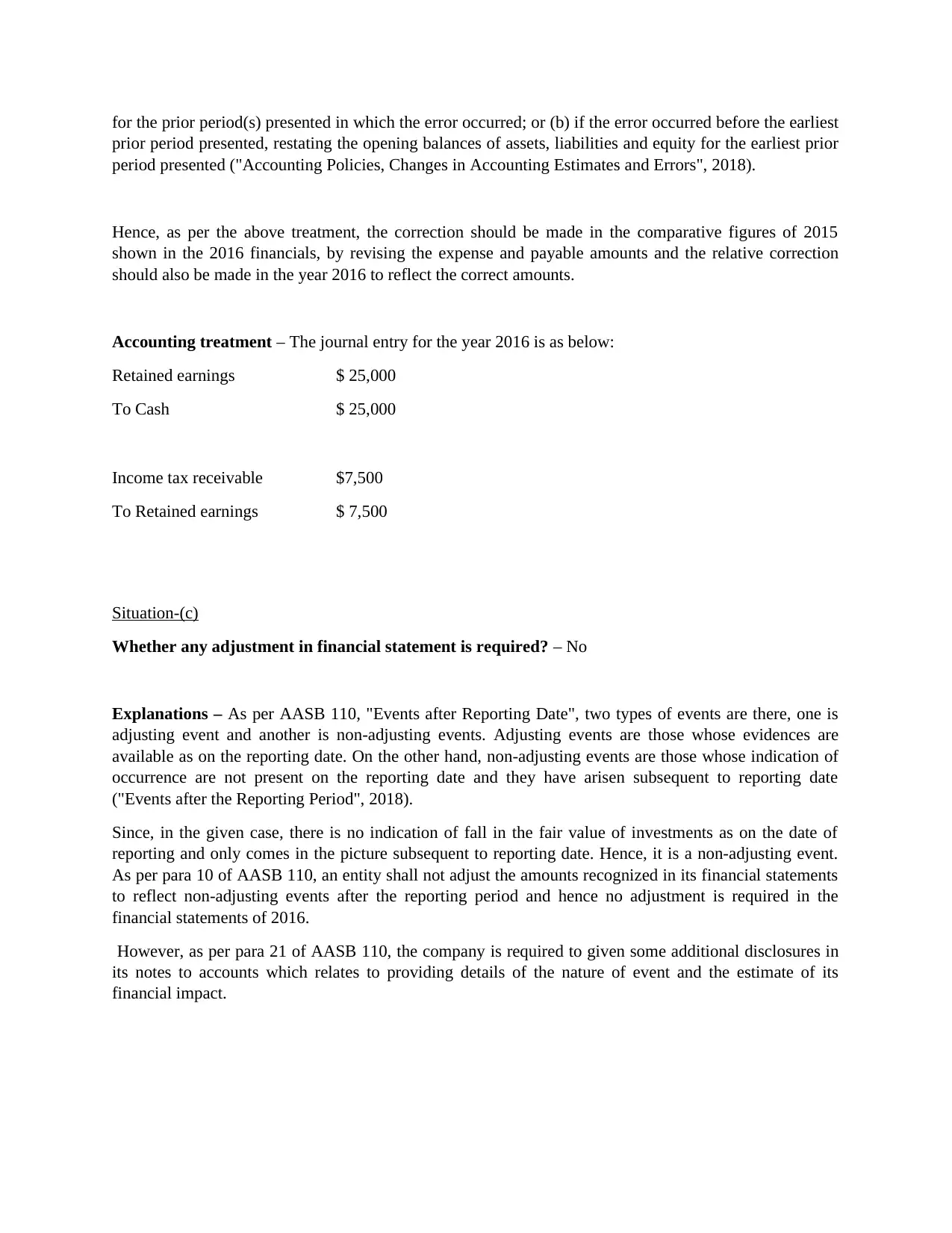
for the prior period(s) presented in which the error occurred; or (b) if the error occurred before the earliest
prior period presented, restating the opening balances of assets, liabilities and equity for the earliest prior
period presented ("Accounting Policies, Changes in Accounting Estimates and Errors", 2018).
Hence, as per the above treatment, the correction should be made in the comparative figures of 2015
shown in the 2016 financials, by revising the expense and payable amounts and the relative correction
should also be made in the year 2016 to reflect the correct amounts.
Accounting treatment – The journal entry for the year 2016 is as below:
Retained earnings $ 25,000
To Cash $ 25,000
Income tax receivable $7,500
To Retained earnings $ 7,500
Situation-(c)
Whether any adjustment in financial statement is required? – No
Explanations – As per AASB 110, "Events after Reporting Date", two types of events are there, one is
adjusting event and another is non-adjusting events. Adjusting events are those whose evidences are
available as on the reporting date. On the other hand, non-adjusting events are those whose indication of
occurrence are not present on the reporting date and they have arisen subsequent to reporting date
("Events after the Reporting Period", 2018).
Since, in the given case, there is no indication of fall in the fair value of investments as on the date of
reporting and only comes in the picture subsequent to reporting date. Hence, it is a non-adjusting event.
As per para 10 of AASB 110, an entity shall not adjust the amounts recognized in its financial statements
to reflect non-adjusting events after the reporting period and hence no adjustment is required in the
financial statements of 2016.
However, as per para 21 of AASB 110, the company is required to given some additional disclosures in
its notes to accounts which relates to providing details of the nature of event and the estimate of its
financial impact.
prior period presented, restating the opening balances of assets, liabilities and equity for the earliest prior
period presented ("Accounting Policies, Changes in Accounting Estimates and Errors", 2018).
Hence, as per the above treatment, the correction should be made in the comparative figures of 2015
shown in the 2016 financials, by revising the expense and payable amounts and the relative correction
should also be made in the year 2016 to reflect the correct amounts.
Accounting treatment – The journal entry for the year 2016 is as below:
Retained earnings $ 25,000
To Cash $ 25,000
Income tax receivable $7,500
To Retained earnings $ 7,500
Situation-(c)
Whether any adjustment in financial statement is required? – No
Explanations – As per AASB 110, "Events after Reporting Date", two types of events are there, one is
adjusting event and another is non-adjusting events. Adjusting events are those whose evidences are
available as on the reporting date. On the other hand, non-adjusting events are those whose indication of
occurrence are not present on the reporting date and they have arisen subsequent to reporting date
("Events after the Reporting Period", 2018).
Since, in the given case, there is no indication of fall in the fair value of investments as on the date of
reporting and only comes in the picture subsequent to reporting date. Hence, it is a non-adjusting event.
As per para 10 of AASB 110, an entity shall not adjust the amounts recognized in its financial statements
to reflect non-adjusting events after the reporting period and hence no adjustment is required in the
financial statements of 2016.
However, as per para 21 of AASB 110, the company is required to given some additional disclosures in
its notes to accounts which relates to providing details of the nature of event and the estimate of its
financial impact.
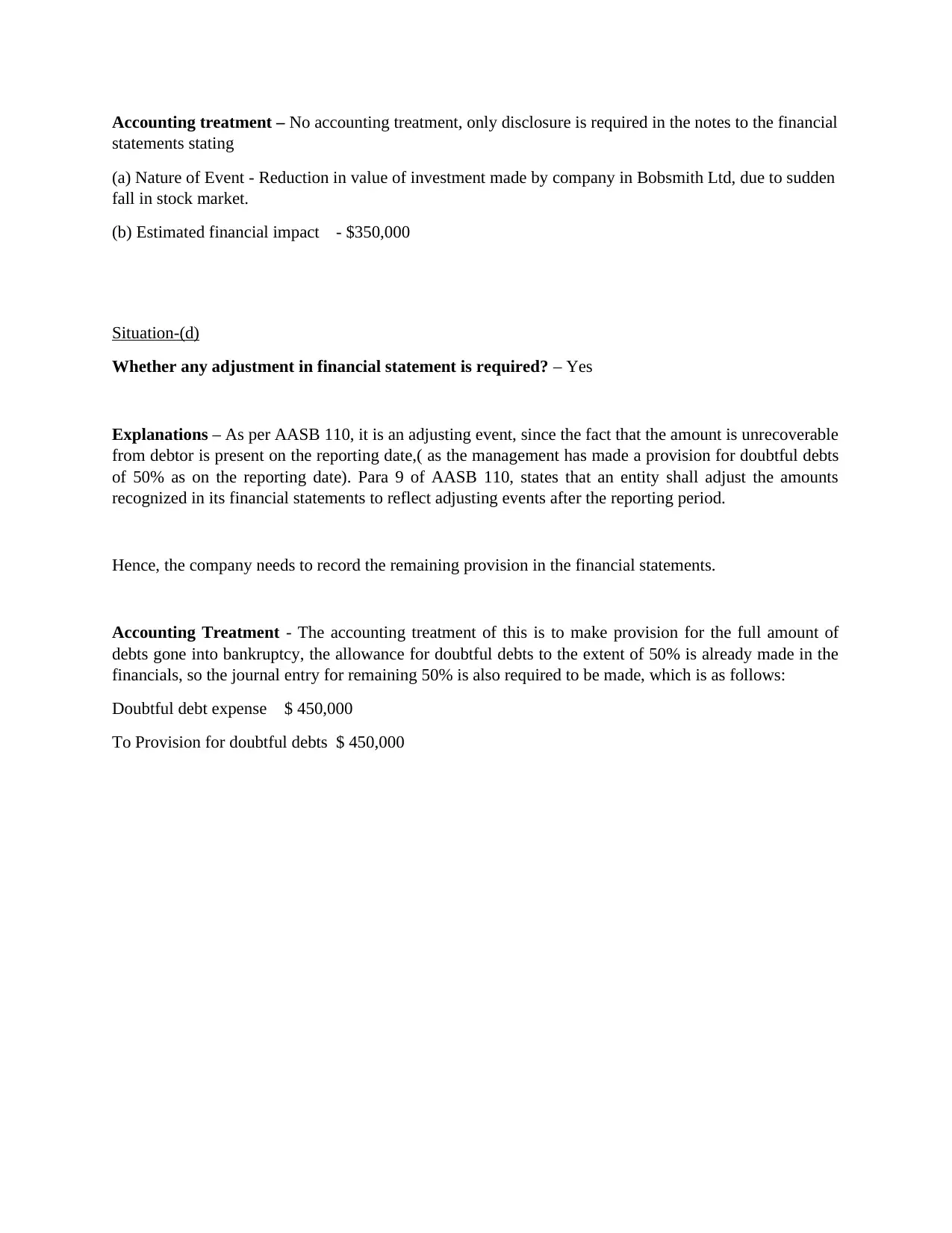
Accounting treatment – No accounting treatment, only disclosure is required in the notes to the financial
statements stating
(a) Nature of Event - Reduction in value of investment made by company in Bobsmith Ltd, due to sudden
fall in stock market.
(b) Estimated financial impact - $350,000
Situation-(d)
Whether any adjustment in financial statement is required? – Yes
Explanations – As per AASB 110, it is an adjusting event, since the fact that the amount is unrecoverable
from debtor is present on the reporting date,( as the management has made a provision for doubtful debts
of 50% as on the reporting date). Para 9 of AASB 110, states that an entity shall adjust the amounts
recognized in its financial statements to reflect adjusting events after the reporting period.
Hence, the company needs to record the remaining provision in the financial statements.
Accounting Treatment - The accounting treatment of this is to make provision for the full amount of
debts gone into bankruptcy, the allowance for doubtful debts to the extent of 50% is already made in the
financials, so the journal entry for remaining 50% is also required to be made, which is as follows:
Doubtful debt expense $ 450,000
To Provision for doubtful debts $ 450,000
statements stating
(a) Nature of Event - Reduction in value of investment made by company in Bobsmith Ltd, due to sudden
fall in stock market.
(b) Estimated financial impact - $350,000
Situation-(d)
Whether any adjustment in financial statement is required? – Yes
Explanations – As per AASB 110, it is an adjusting event, since the fact that the amount is unrecoverable
from debtor is present on the reporting date,( as the management has made a provision for doubtful debts
of 50% as on the reporting date). Para 9 of AASB 110, states that an entity shall adjust the amounts
recognized in its financial statements to reflect adjusting events after the reporting period.
Hence, the company needs to record the remaining provision in the financial statements.
Accounting Treatment - The accounting treatment of this is to make provision for the full amount of
debts gone into bankruptcy, the allowance for doubtful debts to the extent of 50% is already made in the
financials, so the journal entry for remaining 50% is also required to be made, which is as follows:
Doubtful debt expense $ 450,000
To Provision for doubtful debts $ 450,000
Paraphrase This Document
Need a fresh take? Get an instant paraphrase of this document with our AI Paraphraser
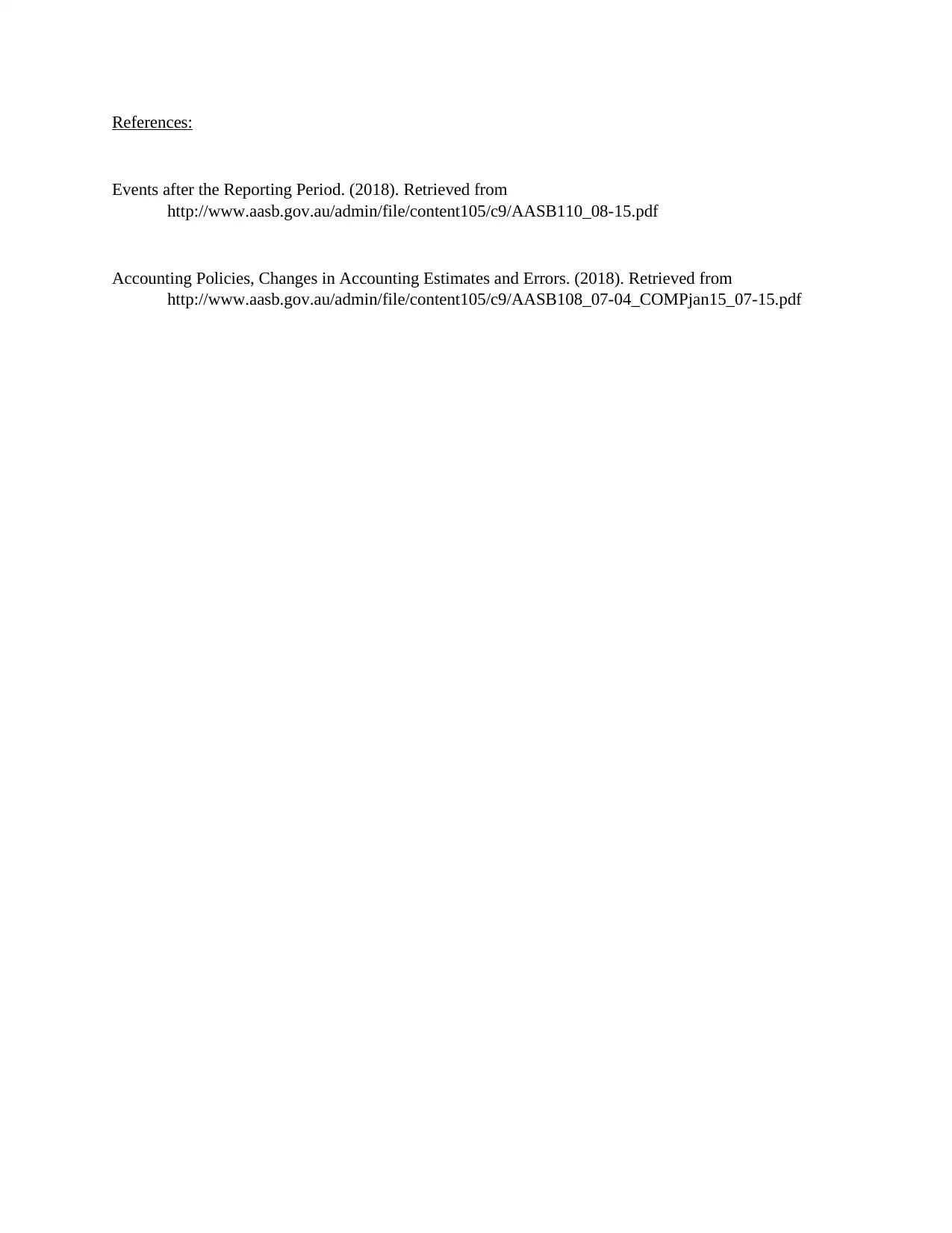
References:
Events after the Reporting Period. (2018). Retrieved from
http://www.aasb.gov.au/admin/file/content105/c9/AASB110_08-15.pdf
Accounting Policies, Changes in Accounting Estimates and Errors. (2018). Retrieved from
http://www.aasb.gov.au/admin/file/content105/c9/AASB108_07-04_COMPjan15_07-15.pdf
Events after the Reporting Period. (2018). Retrieved from
http://www.aasb.gov.au/admin/file/content105/c9/AASB110_08-15.pdf
Accounting Policies, Changes in Accounting Estimates and Errors. (2018). Retrieved from
http://www.aasb.gov.au/admin/file/content105/c9/AASB108_07-04_COMPjan15_07-15.pdf
1 out of 8
Related Documents
Your All-in-One AI-Powered Toolkit for Academic Success.
+13062052269
info@desklib.com
Available 24*7 on WhatsApp / Email
![[object Object]](/_next/static/media/star-bottom.7253800d.svg)
Unlock your academic potential
© 2024 | Zucol Services PVT LTD | All rights reserved.




